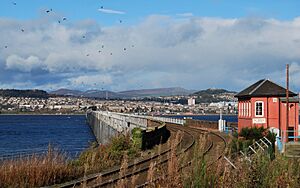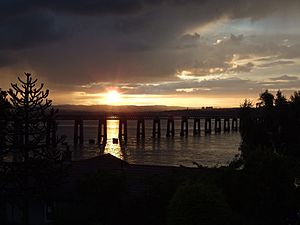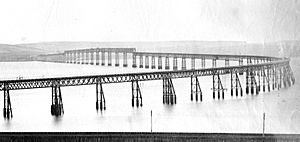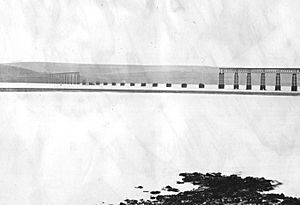Tay Rail Bridge facts for kids
Quick facts for kids Tay Rail Bridge |
|
|---|---|
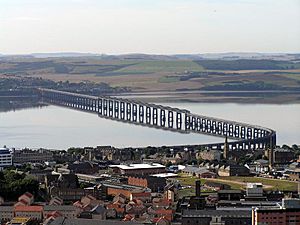
Tay Bridge at Dundee, Scotland
|
|
| Carries | Rail traffic |
| Crosses | Firth of Tay |
| Locale | Dundee to Wormit, Scotland |
| Characteristics | |
| Total length | 3,264 metres (10,709 ft) |
| History | |
| Construction begin | 22 July 1871 (1st) 6 July 1883 (2nd) |
| Construction end | early 1878 (1st) 1887 (2nd) |
| Opened | 1 June 1878 (1st) 13 July 1887 (2nd) |
| Closed | 28 December 1879 (1st) |
The Tay Bridge is a very long railway bridge in Scotland. It stretches about three and a half kilometers (two and a quarter miles). This bridge crosses the Firth of Tay, which is a wide river mouth. It connects the city of Dundee with Wormit, Fife.
People often call it the Tay Rail Bridge. This helps tell it apart from the Tay Road Bridge, which cars use. Before the first rail bridge was built, trains had to cross the river using a special train ferry.
The bridge you see today is actually the second one. The first Tay Bridge fell down in a big storm in 1879. Many people lost their lives in that terrible accident.
Contents
The First Tay Rail Bridge
The first Tay Bridge was designed by a famous railway engineer named Thomas Bouch. He was even made a knight after the bridge was finished. The bridge was made using a special design with a lattice (like a criss-cross pattern). It combined strong cast iron and wrought iron.
This type of design had been used successfully before. For example, it was used for the Crumlin Viaduct in Wales in 1858. However, an earlier cast iron bridge, the Dee bridge, had collapsed in 1847. This was because cast iron parts were not used well.
People had thought about building a bridge across the River Tay since at least 1854. Work on the first bridge officially started on July 22, 1871.
How the Bridge Was Designed
The first plan for the bridge was to have lattice girders. These were supported by brick pillars. The pillars were meant to sit on solid rock under the river. At the ends of the bridge, the single railway track ran on top of the bridge structure. This meant most of the bridge was below the top of the pillars.
But in the middle part of the bridge, called the "high girders," the railway ran inside the bridge structure. This part was built higher up. It allowed tall sailing ships to pass underneath, going upriver to places like Perth.
However, as the builders worked, they found a problem. By December 1873, it became clear that the solid rock was much deeper than expected. It was too deep to be a good foundation for the pillars. So, Thomas Bouch had to change his design.
He decided to use fewer pillars. This meant the sections between the pillars (the "spans") had to be longer. Instead of reaching solid rock, the pillar foundations were built by sinking large, brick-lined iron tubes, called caissons, onto the riverbed.
Building the Bridge
The first company hired to build the bridge went out of business. A new company took over the job. But this new company did not do good work. Many parts of the bridge were not built to a high standard. This included the iron parts and the way they were joined together.
There were problems with the bolts and braces not fitting perfectly. Workers had to make quick, on-the-spot fixes. One person who saw the work later said it was "about as slovenly a piece of work as ever I saw in my life."
Opening the Bridge
The first Tay Bridge opened for passengers on June 1, 1878. The next year, on June 20, 1879, Queen Victoria herself crossed the bridge. She was on her way back south from Balmoral Castle. Thomas Bouch was introduced to her before she crossed. A few days later, on June 26, 1879, the Queen made him a knight at Windsor Castle.
The Tay Bridge Disaster
On the night of December 28, 1879, a terrible event happened. At 7:15 PM, the central parts of the bridge collapsed during a very strong winter storm. A train with six carriages was crossing the bridge at that exact moment. It was carrying seventy-five passengers and crew. The train plunged into the freezing waters of the Tay. Sadly, all seventy-five people on board were lost.
This disaster shocked the entire country. It also made engineers across the world rethink how they built bridges. At the time, a very strong wind was blowing across the Tay river. It was blowing at right angles to the bridge. The train engine was later pulled out of the river and put back into service.
The collapse of the Tay Bridge was a huge tragedy. It had only been open for nineteen months. It had also been declared safe by the government. It remains the most famous bridge disaster in the British Isles. Even today, you can still see the stumps of the original bridge pillars sticking out of the water at high tide.
Why the Bridge Collapsed
An official investigation looked into why the bridge fell. They found that the bridge collapsed because its cross-braces and fastenings were not strong enough. They could not handle the force of the strong wind on December 28, 1879. The report also said the bridge had been weakened by other storms before this one.
However, the investigation also found that the bridge's design itself might not have been the only problem. An engineer who studied the bridge in detail said that even if the bridge had been built perfectly, a very strong wind could have knocked it down. But he also said that the way it fell showed there were weak spots in the bridge. He knew that parts of the bridge had already needed repairs. This showed him that the bridge was not in perfect condition.
The middle section of the bridge, where the train ran inside the high girders, was especially weak. It was top-heavy and very open to strong winds. Neither Thomas Bouch nor the company building the bridge seemed to have checked the factory where the iron parts were made. Iron from a previous, unfinished bridge was even reused there.
The round cast iron columns that held up the longest parts of the bridge (each 75 meters or 245 feet long) were of poor quality. Many were cast lying down, which meant their walls were not the same thickness. There was also some evidence that bad castings were hidden from the people checking the quality. These checks were not very good.
Specifically, some of the small parts (called lugs) used to attach the iron bracing bars were not made correctly. They were "burnt on" instead of being cast as part of the columns. Even the normal lugs were very weak. Tests for the investigation showed they broke under much less weight than they should have. These weak lugs failed during the storm. This made the entire middle of the bridge unstable.
In simple terms, the bridge fell because of problems in how it was made. This meant it could not stand up to the wind as well as its designer had planned.
The Second Tay Rail Bridge
After the disaster, a new bridge was designed by William Henry Barlow. This new bridge has two tracks for trains. It was built by William Arrol & Co. about 18 meters (60 feet) upstream from the old bridge, running parallel to it.
Work on the second bridge began on July 6, 1883. Building it used a huge amount of materials:
- 25,000 metric tons of iron and steel
- 70,000 metric tons of concrete
- Ten million bricks, weighing 37,500 metric tons
- Three million rivets
Sadly, fourteen men lost their lives while building this bridge. Most of them drowned.
The second Tay Bridge opened on July 13, 1887. It is still in use today! In 2003, a big project costing over £20 million was finished. This project strengthened and repaired the bridge. Workers scraped off more than 1,000 metric tons of bird droppings from the bridge's ironwork. They used hand tools and put the droppings into 25 kg sacks. Hundreds of thousands of rivets were removed and replaced. All this work was done high above the fast-moving river, in very windy conditions.
Images for kids
See also
 In Spanish: Puente ferroviario del Tay para niños
In Spanish: Puente ferroviario del Tay para niños


